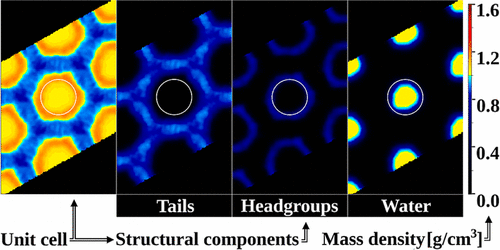Unit cell structure of water-filled monoolein into inverted hexagonal (HII) mesophase modeled by molecular dynamics

The study investigates the unit cell structure of inverted hexagonal (HII) mesophase composed of monoolein (1-monoolein, GMO) and water using atomistic molecular dynamics methods without imposing any restraints on lipid and water molecules. Statistically meaningful and very contrast images of the radial mass density distribution, scrutinizing also the separate components water, monoolein, the polar headgroups of the lipids, the double bond, and the termini of the hydrocarbon chain (the tail), are obtained. The lipid/water interface structure is analyzed based on the obtained water density distribution, on the estimated number of hydrogen bonds per monoolein headgroup, and on the headgroup–water radial distribution functions. The headgroup mass density distribution demonstrates hexagonal shape of the monoolein/water interface that is well-defined at higher water/monoolein ratios. Water interacts with the headgroups by forming a three-layer diffusive mass density distribution, and each layer’s shape is close to hexagonal, which is an indication of long-range structural interactions. It is found that the monoolein headgroups form a constant number of hydrogen bonds leaving an excessive amount of water molecules outside the first lipid coordination sphere. Furthermore, the quantity of water at the monoolein/water interface increases steadily upon extension of the unit cell, so the interface should have a very dynamic structure. Investigation of the hydrocarbon residues reveals high compression and well-expressed structuring of the tails. The tails form a very compressed and constrained structure of defined layers across the unit cell with properties corresponding to a more densely packed nonpolar liquid (oil). Due to the hexagonal shape the 2D packing frustration is constant and does not depend on the water content. All reported structural features are based on averaging of the atomic coordinates over the time-length of the simulation trajectories. That kind of processing allows the observation of the water/GMO interface shape and its stability and mobility at a time scale close to the ones of the intermolecular interactions.

